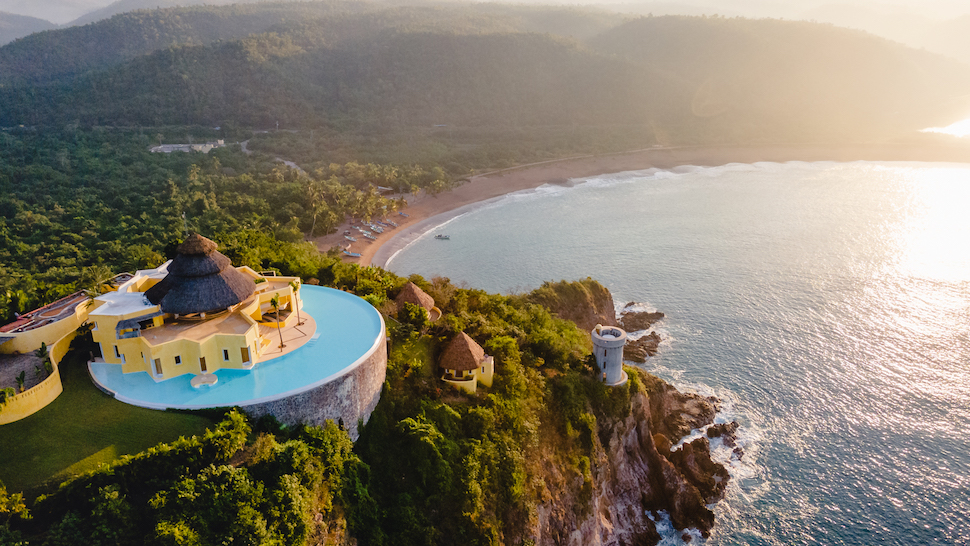
Sound baths, celebrity masseuses, and a cosmic reset on Mexico’s Coast of Joy.
Morning of I don’t know what day it is in Mexico. I’m told the center of the universe—that is, El Centro del Universo—lies a mile or so to the east. I’m told it is the labyrinthine construct of the late Italian patriarch, Gian Franco Brignone, creator of artworks that inform Careyes, this place arisen from his vision. Today I scale the stairway to La Copa del Sol, Brignone’s clifftop sculpture that plays with light. An oft-photographed Wonder of Careyes, it looks like a skyscraper remixed as a concrete bowl.
The Pacific roils and crashes below. Pelicans in formation cruise by at eye level. No boats, no planes. The view from the rim stretches from the rocky face of the headland, past an empty beach, over a tight cut in the bay, and out to a shape-shifting canvas of sea and sky.
Brignone’s artworks invite interaction, flights of fancy, interpretation by the beholder. As does Careyes, the Turin-born developer’s improbable opus: a 25,000-acre utopia on Mexico’s storied Costalegre, the Coast of Joy. Where better to explore spiritual pleasure and physical comfort and vice versa?
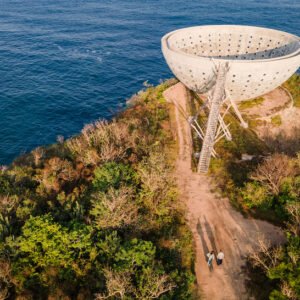
Copa del Sol
By design a paean to feminine principles, La Copa is 88 feet in diameter, 35 feet deep, a popular Playa Teopa spot for sound bathing, which today turns out to be a nidra yoga style guided meditation. For the next nanosecond-hour-lifetime, I lie on the bowl floor, eyes shut, cocooned in a blanket, while Niki Trosky, a winsome Canadian, tantric-trained by way of India, invites me and another neophyte from California to focus our breath, embrace notions of receptive energy, anchor our spines to the center of the earth, and picture a chain connecting those anchors up through the tops of our heads and right out to infinity.
Trosky and her instruments—lilting voice, bamboo chimes, quartz alchemy bowls, a brass gong, a shell horn—level my consciousness like an anesthesiologist’s countdown. Yet I go to some real place. Sound bathing, I’m told, induces deep relaxation and nervous-system rebalancing. What I recall: heightened acoustics, the wind’s audible caress, whole-body connection to space, salt air, oxygen pouring into fingers and toes, an aftermath of lightness and ease apropos to this place.
Playa Teopa, it’s said in Careyes, is where the gods come to rest.
A Cosmic Reset Button
When it comes to wellness, Careyes is an unexpected high, a cosmic reset button, the cure to rushing, crowds, tension, aggression, bad manners, dullness, and urban blight. At its most corporeal, it’s a gated community between Manzanillo and Puerto Vallarta in the Mexican state of Jalisco. Along with its capital of Guadalajara, Jalisco is known for mariachis, rodeos, the Mexican hat dance, and sublime blue agave tequila, of which only the tequila and the mariachis do I ever encounter.
Brignone, a sometime Parisian and former banker, founded Careyes in the early 1970s after one look at the land from a prop plane. Initially he built chic retreats for like-minded family and friends—aristocrats, royalty, titans of industry—largely affluent Europeans and Latin Americans who shared his affinity for art, nature, and mythology.
Now in the hands of Gian Franco’s daughter Emanuela and sons Giorgio and Filippo since his passing in 2022, Careyes today claims some 400 multilingual residents of 42 nationalities with an appetite for sensory beauty and fantastical architecture. Still it remains largely undeveloped, a fairytale enclave surrounded by 50 square miles of federally protected wildlands, jungle rife with iguanas, tejónes, crocodiles, jaguars, bats, countless bird species, and furry tarantulas.
High-Octane Glamour & Raw Nature
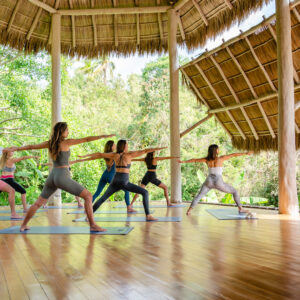 Mornings I wake to the sound of parrots clicking and whistling in the trees outside my terrace and slide back louvered doors to see what’s out on Playa Rosa Bay. A charter boat or two anchored among the pangas. Maybe a whale today. An albatross or three. A lone paddle boarder half a mile offshore. As always, the two pointy islets, the one on the right linked by a cable bridge to Mi Ojo, Gian Franco’s first home, now daughter Emanuela’s cobalt blue villa.
Mornings I wake to the sound of parrots clicking and whistling in the trees outside my terrace and slide back louvered doors to see what’s out on Playa Rosa Bay. A charter boat or two anchored among the pangas. Maybe a whale today. An albatross or three. A lone paddle boarder half a mile offshore. As always, the two pointy islets, the one on the right linked by a cable bridge to Mi Ojo, Gian Franco’s first home, now daughter Emanuela’s cobalt blue villa.
Playa Rosa Beach Club, the Careyes social hub, has soft sand, gentle surf, a badminton net, a shower head bolted to a palm tree, and racks of paddle boards and kayaks. And should one have a craving for a margarita, dorado, carpaccio, grilled artichokes piccata, crème brûlée, an ice cream, or fresh-caught lobster steamed in Pernod, tableside or to-go, it’s on offer at the club’s Barragán-pink seaside restaurant.
Father afield, one can venture to La Plaza de Los Caballeros del Sol, the tile-roofed town center with monolithic outdoor movie screen and enchanting cafes. There’s also horseback riding on the beach or boating to a hidden cove, which may entail spotted dolphins riding the bow and wading ashore for a picnic. So the days unfold.
While social calendars fill up with polo, a film festival, art exhibitions, and sea turtle conservation programs, there’s no nightlife beyond dining out or with the neighbors. Mind you, they’re the sort who commission the Turrell for their vacation home.
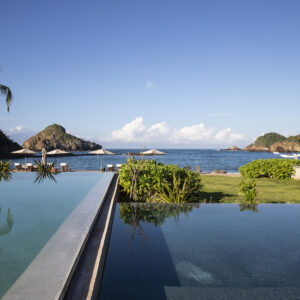
El Careyes Club
Careyes’ 100 or so residences, most seasonal rentals and all with evocative names that serve as addresses (Casa Maoritze, Casa Mango, Casita Gabo, Oriente, Tigre del Mar) range from beach bungalows to hillside casitas to gravity-defying cliffside villas and thatch-roof “castles” encircled by infinity pools, each a feast for the eyes splashed in wildly saturated color. High-octane glamour aside, the lifestyle is as much old-school grace as it is sybaritic. By Brignone tradition, the function of all that eye-catching architecture is to frame the view that connects to the cosmos.
Indeed, the marvel here is to engage with the same raw nature that so captivated Gian Franco in the first place, whether via beach walks, otherworldly art installations, water sports, yoga and meditation, or bodywork with the word-of-mouth healers, whose reputations on the Costalegre precede them.
Yolanda, for instance, goes by one name, like Rhianna or Madonna or Shakira. When people say her name, they nod their heads knowingly, look you in the eye to convey the unspoken, then repeat it. “Yolanda . . . como una curandera, como una chamana, una mujer increíble . . . Yolanda . . . ”
Tapping into the Primal
Yolanda is warm, friendly, chatty. She sets a massage table up on my terrace and fires up a stick of copal, heady incense made from indigenous tree resin. In vogue in Mexico now for a few thousand years, it’s said to have purifying medicinal properties. She starts in on my back. She once worked at the Hotel Bel-Air in Los Angeles, she tells me. “¿Pero qué puedes hacer in 45 minutos? Fue imposible!” She talks like your girlfriend salon stylist while her hands tap into the primal.
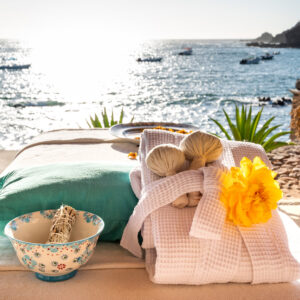 “¡¿Qué es esto?!” she says, seizing on what her fingers find. “¡¿Quién es ese?!” she says, tsk-tsking at her uncanny discoveries. Yolanda’s hands read a body like the codex to the psyche. Not so much to blocked energy and knotty shoulders as to molecular cause and effect. From touch, Yolanda divines what should be soothed and the who and what that need vanquishing.
“¡¿Qué es esto?!” she says, seizing on what her fingers find. “¡¿Quién es ese?!” she says, tsk-tsking at her uncanny discoveries. Yolanda’s hands read a body like the codex to the psyche. Not so much to blocked energy and knotty shoulders as to molecular cause and effect. From touch, Yolanda divines what should be soothed and the who and what that need vanquishing.
The saying goes that Careyes itself determines destiny—who comes and stays and who goes.
“Let’s get rid of that s—,” she laughs, as I deep breathe into and exhale it. “Pardon my English!”
An hour or a year later, she sits me up in my swaddled sheet, hands me a piece of chocolate like the key to kingdom, and gives my remoleculed self a hug. I would say lucky me, but I’m told there’s no such thing as luck in Careyes, nor coincidences.
The saying goes that Careyes itself determines destiny—who comes and stays and who goes.
Come evening I join friends to sip tequila, to catch the sun dropping into the sea. We share stories over dinner and talk of world events with a certain freedom and remove, as if they were unfolding on a distant planet; the way, when one travels, the obligations of daily life shrink the minute the plane lifts from the ground and the replenished soul fills the loosed space.
On the Costalegre, that space seems timeless and infinite, and who wouldn’t want to feel that lightness of belonging and freedom all the time, or at least part of the year, or even once in a lifetime.
Where to Stay
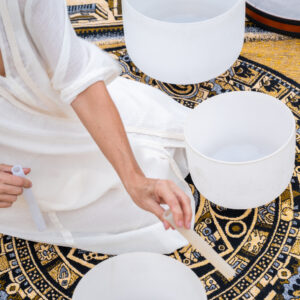
Sound healing
Careyes Whatever your accommodations in Careyes, the property manager or concierge can arrange for La Copa sound baths, private or group yoga, and in-room facials, body treatments, and massage, as well as paddle sports, scuba diving, boating, and horseback riding.
El Careyes Club & Residences This compound of modernist design and minimalist décor in serene neutrals is a short walk to Playa Rosa, with 35 rooms and suites, restaurants, bars, and five luscious infinity pools. Rates: from $300 per night.
Casa Mango, Casitas de las Flores Canary walls frame sunsets over Playa Rosa Bay at this four-bedroom Casitas de las Flores haven appointed in Mexican art and ceramics, Guatemalan textiles, and Indian antiques. Rates: from $900 per night.
Beach Bungalows, Villas, and Castles Cozy orange and fuchsia bungalows preside right on Playa Rosa. At the other end of the spectrum are fully staffed villas and stratospheric castles like the cerulean blue Tigre del Mar or chrome yellow Sol de Oriente with aquamarine infinity pool. Rates: bungalows from $350 per night; villas and castles, $2,300 to $10,000 per night.
Costalegre Hotels
The Brignones were the first to develop the Costalegre, but not the last. In the 1980s, James Goldsmith, a French-English financier, built his version of paradise ten miles south of Careyes. His artful 25,000-acre estate turned hotel—a Mexican, European, Moorish fantasy complete with menagerie of antelopes and zebras—has been owned and operated as Cuixmala for the last two decades by his daughter Alix Goldsmith-Marcaccini. Wellness offerings here include crystal sound healing, yoga, Pilates, massage, meditation, cranio-sacral therapy, organic spa amenities from the on-site farm, and RASHA scalar-plasma sound technology treatments.
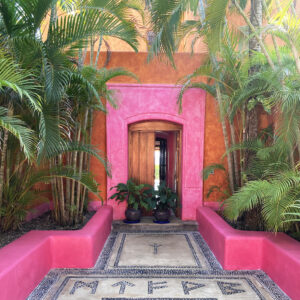
Las Alamandas; photo by Trish Reynales
And 20 miles north of Careyes, opened in the 1990s and the award-winning creation of Goldsmith’s daughter Isabel Goldsmith-Patiño, Las Alamandas is a neon-pink, family-friendly wonderland on 2,000 acres with endless gardens, clouds of bougainvillea, four private beaches, a seaside playground, a spa palapa, treatment and steam rooms, a salon, yoga studio, and gym. Aromatherapy specialty? The Coffee, Chocolate, and Lavender Exfoliation.
The newest addition to the landscape, the Four Seasons Resort Tamarindo opened in 2022 at the Costalegre’s southerly reaches. The de facto choice of politicians with security details (Bill Clinton, Gavin Newsom), its attractions include 18-hole golf, a fitness center, a sweat lodge, a luxe spa specializing in couples therapies, and a helipad.
Finally, in the works just north of Las Alamandas is Xala, an ambitious regenerative development (hotels, residences, restaurants, spa, cultural center, skateboard park, football field). Backed by UK-based developers and celebrity investors that include Richard Gere, it’s slated to open in 2026.
Trish Reynales
Trish Reynales is a Santa Barbara-based travel and arts writer and the former editor in chief of Virtuoso Life and Caribbean Travel + Life. Her work has appeared in numerous publications, including C Magazine, Condé Nast Traveler, and The Los Angeles Times.